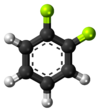1,2-Difluorobenzene
|
|
|||
| Names | |||
|---|---|---|---|
|
Preferred IUPAC name
1,2-Difluorobenzene
|
|||
| Other names
o-Difluorobenzene
ortho-Difluorobenzene |
|||
| Identifiers | |||
|
3D model (JSmol)
|
|||
| ChEBI | |||
| ChemSpider | |||
| ECHA InfoCard | 100.006.074 | ||
|
PubChem CID
|
|||
|
|||
|
|||
| Properties | |||
| C6H4F2 | |||
| Molar mass | 114.093 g/mol | ||
| Appearance | colorless liquid | ||
| Density | 1.1599 g/cm3 | ||
| Melting point | −34 °C (−29 °F; 239 K) | ||
| Boiling point | 92 °C (198 °F; 365 K) | ||
| (insoluble) 1.14 g/L | |||
|
Except where otherwise noted, data are given for materials in their standard state (at 25 °C [77 °F], 100 kPa).
|
|||
|
|
|||
| Infobox references | |||
1,2-Difluorobenzene, also known as DFB, is an aromatic compound with formula C6H4F2. This colorless liquid is a solvent used in the electrochemical studies of transition metal complexes.
1,2-Difluorobenzene is prepared by a simple substitution reaction of fluorine with fluorobenzene.
The 1,4-isomer and small amounts of the 1,3-isomer are also produced in the reaction as the fluorine group on the aromatic ring of fluorobenzene is ortho- and para- directing.
1,2-Difluorobenzene has been used as solvent for the electrochemical analysis of transition metal complexes. It is relatively chemically inert, weakly coordinating, and has a dielectric constant high enough to dissolve many electrolytes and metal complex salts. It is used as a weakly coordinating solvent for metal complexes, alternative to the relatively more strongly coordinating solvents acetonitrile, DMSO, and DMF.
1,2-Difluorobenzene can be acylated to 3',4'-difluoropropiophenone, which has interesting application in the synthesis of halogenated cathinone/PPA congeners.
...
Wikipedia


